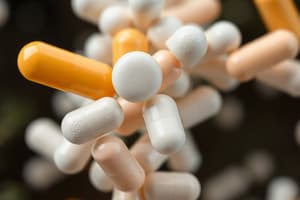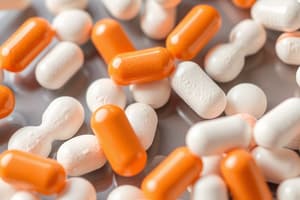Podcast
Questions and Answers
What is the mechanism of action of cephalosporins?
What is the mechanism of action of cephalosporins?
- Inhibition of DNA gyrase
- Activation of bacterial efflux pumps
- Inhibition of protein synthesis
- Inhibition of mucopeptide synthesis in the bacterial cell wall (correct)
Which of the following organisms are cephalosporins most effective against?
Which of the following organisms are cephalosporins most effective against?
- Viruses
- Rapidly growing organisms forming cell walls (correct)
- Anaerobic bacteria
- Fungi
How are first generation cephalosporins classified based on their spectrum of activity?
How are first generation cephalosporins classified based on their spectrum of activity?
- Based on their antibacterial activity
- Based on their chemical structure
- Based on the order of development (correct)
- Based on their clinical utility
Why are cefoxitin and cefotetan included with the cephalosporins despite being cephamycins?
Why are cefoxitin and cefotetan included with the cephalosporins despite being cephamycins?
What makes cephalosporins bactericidal?
What makes cephalosporins bactericidal?
How many generations is the cephalosporin class of drugs divided into based on the order of development?
How many generations is the cephalosporin class of drugs divided into based on the order of development?
What is the impact of renal function impairment on the half-life of most cephalosporins?
What is the impact of renal function impairment on the half-life of most cephalosporins?
When should dosage adjustments be considered for most oral cephalosporin agents?
When should dosage adjustments be considered for most oral cephalosporin agents?
In what scenario should cefotaxime be used instead of ceftriaxone in patients with severe hepatic impairment?
In what scenario should cefotaxime be used instead of ceftriaxone in patients with severe hepatic impairment?
What pregnancy category are cephalosporins classified as?
What pregnancy category are cephalosporins classified as?
Why should the use of cephalosporins during pregnancy be based on a risk/benefit determination?
Why should the use of cephalosporins during pregnancy be based on a risk/benefit determination?
What is the maternal to fetal serum ratio for cephalosporins?
What is the maternal to fetal serum ratio for cephalosporins?
Which of the following Enterobacteriaceae species are typically resistant to cephalosporins?
Which of the following Enterobacteriaceae species are typically resistant to cephalosporins?
What is a unique characteristic of cephamycins compared to other generations of cephalosporins?
What is a unique characteristic of cephamycins compared to other generations of cephalosporins?
Which of the following have increased activity against H. influenzae compared to first generation cephalosporins?
Which of the following have increased activity against H. influenzae compared to first generation cephalosporins?
What is a notable exception regarding the activity of ceftaroline among cephalosporins?
What is a notable exception regarding the activity of ceftaroline among cephalosporins?
Which of the following cephalosporins is active against both gram-positive and gram-negative organisms, including Pseudomonas?
Which of the following cephalosporins is active against both gram-positive and gram-negative organisms, including Pseudomonas?
What is the main concern associated with the use of third generation cephalosporins against uncommon gram-negative pathogens?
What is the main concern associated with the use of third generation cephalosporins against uncommon gram-negative pathogens?
What do second generation cephalosporins have increased activity against compared to first generation cephalosporins?
What do second generation cephalosporins have increased activity against compared to first generation cephalosporins?
Which generation of cephalosporins is known for having activity against Pseudomonas aeruginosa?
Which generation of cephalosporins is known for having activity against Pseudomonas aeruginosa?
Which characteristic is responsible for the resistance of MRSA, DRSP, Enterococcus faecalis, and Enterococcus faecium to cephalosporins?
Which characteristic is responsible for the resistance of MRSA, DRSP, Enterococcus faecalis, and Enterococcus faecium to cephalosporins?
Which cephalosporin is particularly active against most gram-positive and gram-negative pathogens, including resistant strains?
Which cephalosporin is particularly active against most gram-positive and gram-negative pathogens, including resistant strains?
Which cephalosporin is advised to be avoided in neonates at risk for hyperbilirubinemia, especially preterm infants, due to high albumin binding?
Which cephalosporin is advised to be avoided in neonates at risk for hyperbilirubinemia, especially preterm infants, due to high albumin binding?
Which generation of cephalosporins readily enter the CSF in the presence of meningeal inflammation?
Which generation of cephalosporins readily enter the CSF in the presence of meningeal inflammation?
What is the main route of excretion for most cephalosporins?
What is the main route of excretion for most cephalosporins?
Which drug combination is used in serious infections and single-dose therapy for sexually transmitted infections to increase cephalosporin plasma concentrations?
Which drug combination is used in serious infections and single-dose therapy for sexually transmitted infections to increase cephalosporin plasma concentrations?
Flashcards are hidden until you start studying





